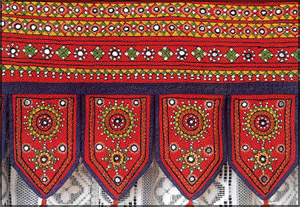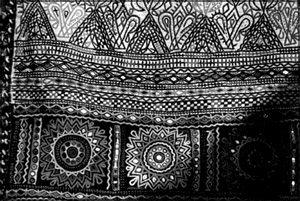|
Gujarat's Embroidery:
"Marvellously beautiful"
Shaheen Perveen
Gujarat's
contemporary dress style is a cultural manifestation that has evolved
over centuries and has remained a principal mark of identity and social
cohesion. Though dress is indicative of one's position in social
hierarchy, it is also one of the first indicators of identity that
disappears in the process of cultural assimilation and racial mingling.
 The
ethnic embroidery in Gujarat is almost synonymous with Kutch, which was
once a part of the trade route between Central Asia and the Far East.
Given Gujarat's coastline and numerous harbours, it exposed the land to
the outside influences. The
ethnic embroidery in Gujarat is almost synonymous with Kutch, which was
once a part of the trade route between Central Asia and the Far East.
Given Gujarat's coastline and numerous harbours, it exposed the land to
the outside influences.
Some of the best and oldest textiles were created in Gujarat and they
were in great demand in other parts of Asia. Old residents of Kutch
still recount romantic tales of caravans laden with silk, pearls,
carpets etc. traversing the Rann of Kutch to reach the port cities.
Exposure to the outside world had its effect on embroidery as well.
The women of Kutch weave a magical world of colour and celebrate
everyday life. Elements and traces of Baluch or Sindhi embroidery
merging with those of the Kutch is well established. Marco Polo, writing
about Gujarat said, "They also work here beautiful mats in red and blue
leather, exquisitely inlaid with figures of birds and beasts and
skilfully embroidered with gold and silver wire.
They are marvellously beautiful things; they are used by the Saracens
to sleep upon."
Embroidery in Gujarat is akin to ritual decoration and can be found
everywhere. Toran is the most common embroidered doorway decoration with hanging flaps supposed to bring good
luck.
embroidered doorway decoration with hanging flaps supposed to bring good
luck.
Pachitattis are hanged from the corners as a welcome symbol to the
visitors. Chaklas are embroidered square pieces of cloth used as
furniture cover, while Bhitiya is the impressive wall hanging. Mirror
inset embroidery or Abhala has now become a part of the ethnic chic
fashion world, where small mirror discs are fixed with closely worked
silken thread.
Usually the mirror work is done on a dark background with motifs like
flowers, creepers, petals etc. Though the motifs are inspired by daily
life happenings, ancient beliefs and rituals, they vary from place to
place and are passed down the generations from mother to daughter.
It is not unusual in Kutch to find young girls, their mother and even
grandmother sitting together to create the best of cholis.ghagras,
odhinis (blouse, skirt and head-cover) bed spreads, bags, wall hanging
and a variety of ornamental pieces for home decor.
Until recently long hours were spent to create the best in embroidery
for personal use but today things are somewhat organised and speedier in
order to cater to the needs of the tourists as well. At a very early age
the girls acquire embroidery skills, honed by generations, and with
pride and patience they prepare their own trousseau.
 Each
community in Kutch has its own distinctive style of needlework.
Geometric patterns of Sauf embroidery by the Sodha community appear to
be the earliest extension of Iranian Baluchistan influence. The time
consuming needlework involves stitches on the base by counting every
single thread that imparts a uniform, balanced look as if the design was
woven on cloth. Sodha Rajputs migrated to Gujarat from Pakistan during
the 1971 Indo-Pak war. Each
community in Kutch has its own distinctive style of needlework.
Geometric patterns of Sauf embroidery by the Sodha community appear to
be the earliest extension of Iranian Baluchistan influence. The time
consuming needlework involves stitches on the base by counting every
single thread that imparts a uniform, balanced look as if the design was
woven on cloth. Sodha Rajputs migrated to Gujarat from Pakistan during
the 1971 Indo-Pak war.
Ari embroidery is equally old and famous for its heavy work. Prepared
with the help of an awl, it represents a cobbler's stitch which requires
considerable skill and practice. The sharper and finer the hook of the
awl, the more refined the quality of the embroidery.
This is done in silk, or locally made satin called Gajji or on a
silky satin fabric. Atlash. Ari embroidery was patronised by the royal
ladies of Kutch who were fascinated by the Persian motifs like peacock
and flowers. The garments with Ari embroidery are usually dotted with
bootis (leaves) which round off with big ones known as Nadir Shahi booti.
Rabari embroidery is the most prominent work and widely available.
The women of Rabari community wear black skirts with creative edges
embroidered, and so are their profusely decorated veils with tie and dye
patterns. A Rabari bridegroom's embroidered logcoat is worth a look.
Even children wear heavily embroidered salwars and shirts.
The Kutch Rabaris make use of mirrors of various shapes and sizes and
therefore their works have a variety though they stick to minute chain stitches.The finest embroidery with
most intricate patterns created by the needle comes from Mutwa and Jat
communities.
though they stick to minute chain stitches.The finest embroidery with
most intricate patterns created by the needle comes from Mutwa and Jat
communities.
The Mutwas, living in Banni, excel in all styles of embroidery and
they work out the tiny mirrors with ease. Fine hand spun cotton and
quality silk is used in red, white, golden yellow, blue and black to
develop patterns and booties interspread with birds and animals motifs.
The Jats, who migrated from Baluchistan, are experts in inserting the
smallest of the mirrors with utmost perfection, amidst pleasing colours
and design that are usually geometric patterns.
The ladies from Lobana community in Banni create fantasy with silk
thread thickly piled in deep orange, golden yellow, dark red and bright
blue. The bootis are inset with mirrors, making use of chain stitch,
buttonhole stitch, etc.
Applique or Katab is another form of decorative needlework, more
pronounced in Saurashtra where women from the darzi (tailor) community
prepare it for commercial use. Its origin relates to a tailor's wife who
saved the cloth remnants in the shop, which finally created quilt
covers, and other decorations. After all, nothing should go waste.
Unlike the Pipli work of Orissa, here it is done in patchwork based
on pieces of coloured and patterned fabric, which is finely cut to serve
the motif and then stitched on to a plain background to produce quilts,
curtains and wall hangings. Patchwork quilts from Kutch are worked upon
by neat running stitches and are quite popular with tourists.
The higher the pile of quilts, the higher the owner's status, for, it
establishes his ability to accommodate a number of guests
simultaneously.Next to garments and home decors, a variety of
decorations are created for the bullocks, horses, camels and palanquins.
Horn covers or Shinghadiwas, forehead covers, saddles, body hanging
and neck ornaments for bullocks and camels are most popular. Leather
embroidery is a later addition in the long list of marketable craft. Now
embroidered jootis (shoes) of Banaskantha are quite popular along with a
variety of leather products including bed spreads!
by courtesy: India Perspectives |
